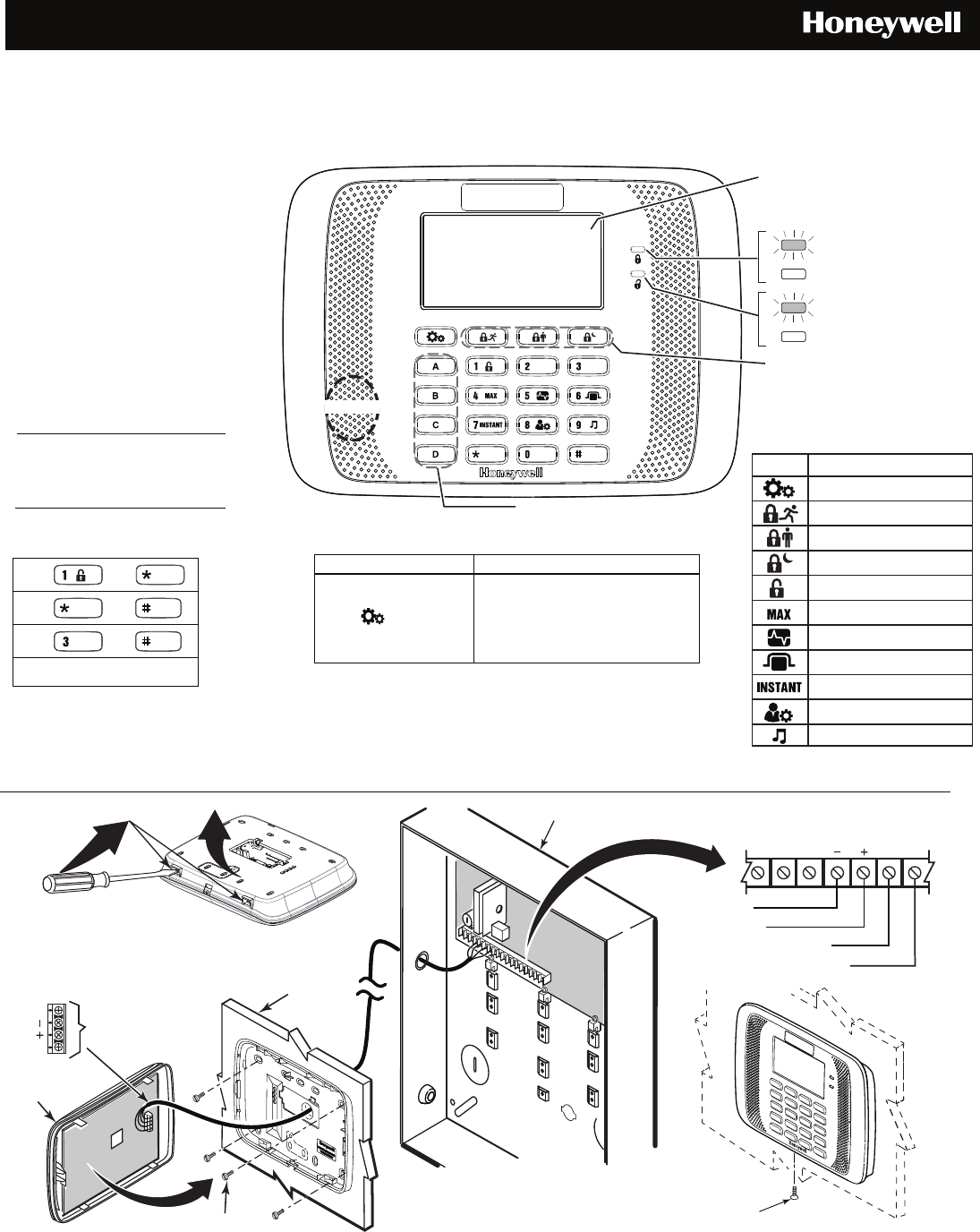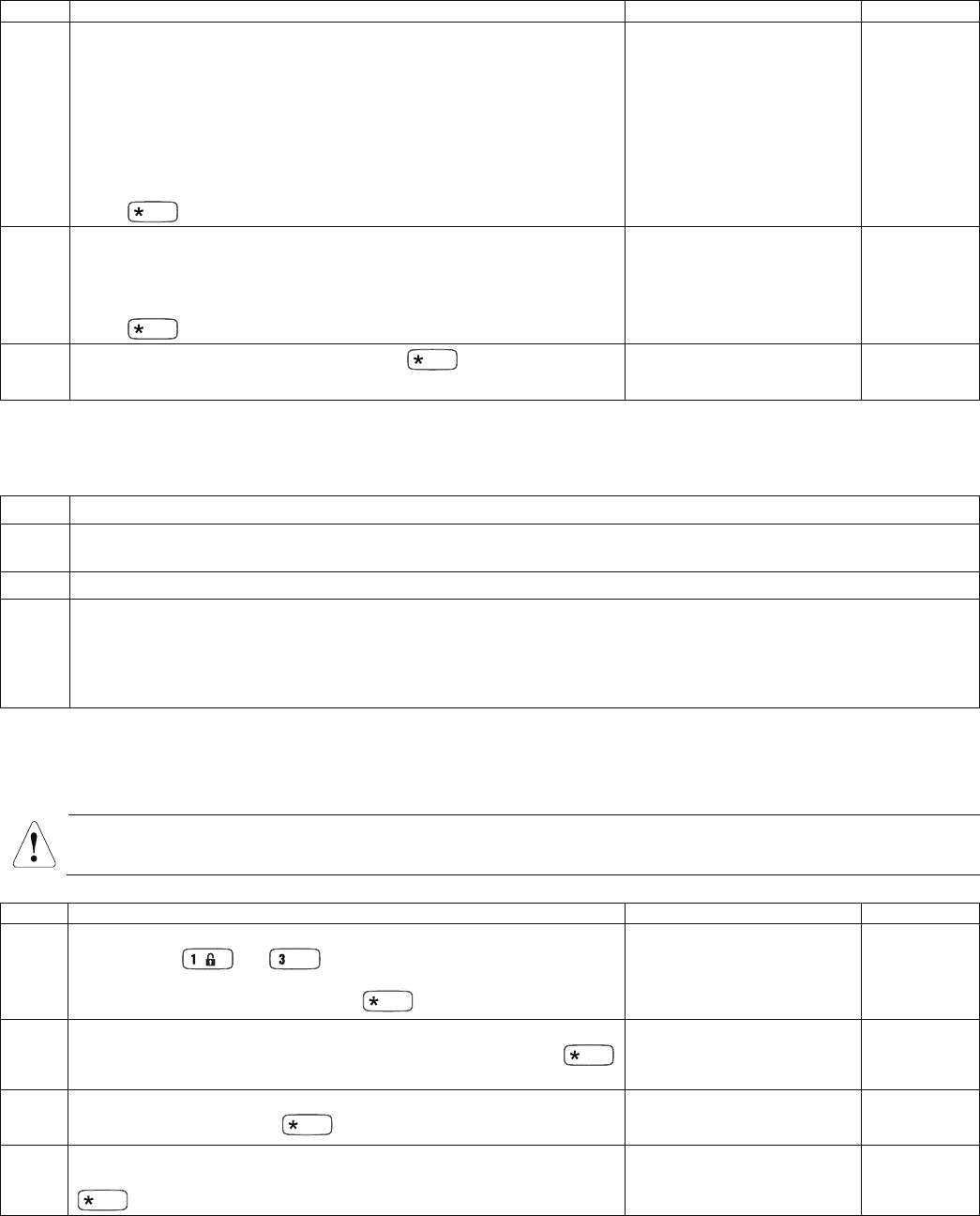Ademco 8DL6162RF Keypad Transceiver User Manual 800 11508 A 6162RF ig 04 03 13
Honeywell International Inc. Keypad Transceiver 800 11508 A 6162RF ig 04 03 13
Ademco >
Users Manual

ADEMCO 6162RF Keypad / Transceiver – Installation and Setup Guide
Alphanumeric Addressable Keypad/Transceivers for use with Honeywell Control Panels; incorporates functions
of a High RF Receiver and a 5800 Transmitter module.
= READY to Arm
= NOT READY to Arm
= System ARMED
= System NOT ARMED
Arming Keys
6162: 4-Line Alpha Display
Custom Zone Designators
6162rf-KEYPAD-LBLD-V0-032713
Programmable Function Keys
Sounder
Wall
Surface
Control Panel Terminal Strip
AU X DATA
IN
DATA
OUT
AUX
2
1
Y
G
To Control Panel
Terminal Strip
Optional Front Cover Securing Screw
(Required in European Installations)
Install Four (4)
Mounting Screws
Control Panel
1. OPEN
Keypad
Front Cover
2. WIRE
3. MOUNT
• Connect only one wire per terminal.
• For Daisy-Chain Configurations, use
wire splicing so only one wire is
connected to each terminal.
• Mount on drywall, or in
a single or double-gang
electrical box.
6162RF-installation-3-21-13
Black (Gnd)
Red (+12vdc)
Green (Data To Control)
Yellow (Data From Control)
To activate Function keys,
press and hold key for at
least 2 seconds; key pairs
are activated immediately.
Table 1 – Programmable
Function Keys
A or and
B or and
C or and
D
Note: See the control's instructions for
details on programming the Function
keys for panic alarms or other special
functions (i.e., macros).
• Supports wireless key transmitters
(e.g., 5834-4) and bi-directional
transmitters (e.g.; 5804BD,
5828/5828V).
• Supports wireless keys with high-
security (encryption) capability (e.g.;
5834-4).
• Provides a nominal range of 200
feet for RF transmitters (some
transmitters have a shorter range).
• Supports RF jam detection.
Table 3 – Icon Descriptions
ICON DESCRIPTION
TEST SYSTEM
BYPASS ZONES
ASSIGN CODES
CHIME MODE
ARM MAXIMUM
ARM INSTANT
ARM AWAY
ARM NIGHT STAY
DISARM
ARM STAY
SETTINGS
Table 2 – Settings Ke
y
Settings Ke
y
Result
Press
Displays Settings Menu*:
1 Set Time/Date
2 View Event Log
3 Reboot Keypad
4 Set User Code**
* Follow instructions in the User Guide for these options; selecting
option 3 reboots the 6162 keypad.
** Set User Code option available only with the following Control
Panels: VISTA-10P Rev 4.16, VISTA-15P Rev 9.16, VISTA-
20P Rev 9.16 and VISTA-21iP Rev 3.16.
GO TO PAGE 4
FOR FCC / IC
INFORMATION

- 2 -
APPLICATION GUIDELINES FOR THE 6162RF
Table 4 – Application Guidelines
If… And… Then…
This is the only
transceiver on
the system,
You want to use both
the receiver and
transmitter function
on a single-partition
system,
• Set the keypad to a device address assigned to the desired partition.*
• Enable the receiver.
• Program a system House ID in the control panel (this will enable the transmitter
function).**
• Set the wireless devices that will communicate with this 6162RF to the same
system House ID.
There is another
receiver or
transceiver on
the system,
You want to use only
the transmitter
function on a second
partition,
• Set the keypad to a device address assigned to the desired partition.*
• Disable the receiver.
• Program a DIFFERENT House ID in the 6162RF than is programmed in the control
panel.*/ **
• Set the wireless devices that will communicate with this 6162RF to the same
House ID as the 6162RF.
You want to use only
the transmitter
function on a single-
partition system,
• Set the keypad to a device address assigned to the Partition 1.
• Disable the receiver.
• Program a House ID in the 6162RF that matches the system House ID
programmed in the control panel.*
• Set the wireless devices that will communicate with this 6162RF to the same
House ID.
Notes:
* On VISTA-40 panels and above, wireless keypads (e.g., 5828) can only be used on a single partition. This partition is programmed in field 1*48,
and must match the partition assigned to the 6162RF. Wireless keys can be used on more than one partition, using a House ID programmed in the
6162RF and the devices. In this case, the wireless keys must be assigned to the same partition as the 6162RF.
** On VISTA-20P panels, the 6162RF will use the House ID programmed in the panel for the partition to which it is assigned. Wireless keypads can
only be used on Partition 1.
4. PROGRAM
Refer to the following procedure to program the 6162RF:
Table 5 – 6162RF Programming
STEP DESCRIPTION DISPLAY CHOICES
1. Enter Programming Mode: Within 60 seconds of power up, press and hold down the and keys at the
same time for 3 seconds.
2. Keypad Address. The keypad address appears (Default = 16). Enter
a two-digit keypad address. Press the key to continue.
Notes: – Refer to the control panel’s installation instructions for the
acceptable keypad addresses.
CON ADDR = 16 00-31
3. Receiver Enable. Enter [1] to enable, or [0] to disable the receiver.
Press to continue.
RECEIVER
ON [0= OFF]
1 = ON
0 = OFF
4. Receiver Address. If the receiver is enabled, enter the two-digit
receiver address. (00-30).
Note: Refer to the control panel’s installation instructions for the acceptable
receiver addresses.
Press to continue.
REC ADDR = 00 00-30
5. User Code. Enter a valid four-digit user code to enable single button
arming keys. The user code must be programmed in the control.
Press to continue.
USER CODE : ****
0000-9999

- 3 -
Table 5 – 6162RF Programming (continued)
STEP DESCRIPTION DISPLAY CHOICES
6. House ID. This prompt will only appear if the receiver is disabled. If the
receiver is enabled the 6162RF will use the House ID programmed in
the panel. Refer to Application Guidelines section when selecting a
House ID.
To program a House ID: Enter 01-31
To disable the transmitter: Enter 00
Note: Each device that will receive status from the 6162RF must be set to the
same House ID as the 6162RF (refer to Application Guidelines section).
Press to continue.
HOUSE ID = XX 01-31
00 = Disable
Transmitter
7. Enable High Security Mode. Enter [1] to select High Security Mode.
Note: If the High Security mode is enabled, the 6162RF will only recognize
encrypted devices. If the High Security mode is disabled, the 6162RF will
process commands from both encrypted and non-encrypted devices.
Press to continue.
HIGH SECURITY
OFF [1 = ON]
1 = ON
(Enable)
0 = OFF
(Disable)
8. Disable High Security Devices. Press the key to skip this
prompt and exit Program Mode.
DISABLE HS DEV?
NO [1 = YES]
1 = YES
0 = NO
ACTIVATING HIGH SECURITY DEVICES
The procedure below should be followed when using High-Security (encrypted) devices.
Table 6 – Activating High Security Devices
STEP DESCRIPTION
1. Follow the normal procedure for programming the device into the control panel (refer to the Installation Instructions for
the device that you are programming). Exit out of Programming Mode.
2. Put the control panel in Go / No Go Test mode. (See the Installation Guide for the panel being installed.)
3. Follow the instructions supplied with each wireless device to enroll the device in High-security mode. After each device
is enrolled, the 6162RF will momentarily display “SECURITY DEVICE” along with the device number and its serial
number.
Note: The 6162RF will support a maximum of 8 devices. If you attempt to enroll additional devices the keypad will display
“EXCEEDED NUMBER” “ALLOWED DEVICES”.
CHANGING USER CODE AND DISABLING HIGH SECURITY DEVICES
This mode gives you the ability to change the user code used to enable the single button arming keys and disable high security on
all wireless keys that have been enrolled in the 6162RF. The disable high security devices option is particularly useful if a user loses
a wireless key.
Once high-security (encrypted) devices have been disabled, they will only operate if the 6162RF is set to listen to both
encrypted and non-encrypted devices (programming step 6 in Table 5). To completely disable the devices, they must be
deleted from the control panel.
Table 7 – Disabling High Security Devices
STEP DESCRIPTION DISPLAY CHOICES
1. After the keypad has been powered for at least 60 seconds, press and
hold down the and keys at the same time for 3 seconds.
The current keypad address will be displayed. (You cannot change the
keypad’s address at this point.) Press to continue.
CON ADDRESS=XX Programmed
Keypad
address
appears
2. User Code. At the User Code prompt, enter the valid 4-digit user code
that will be used to enable the single button arming keys.. Press
to continue.
USER CODE : **** 0000-9999
2. Delete High Security Devices. Enter [1] to remove all high-security
(encrypted) devices. Press to continue.
DELETE DEVICES?
NO [1 = YES]
1 = YES
0 = NO
3. If YES was selected in Step 2 the unit will display a confirm request to
delete the stored high security device. Enter [1] to accept and press
to exit the programming mode.
ARE YOU SURE?
NO [1 = YES]
1 = YES
0 = NO

TROUBLESHOOTING
The error messages listed in the following table cause the 6162RF to produce a single ding tone. The table describes the error
messages and the corrective actions.
Table 8 – Troubleshooting
Display Probable Cause Corrective Action
Open Ckt No data is being received from the control
panel.
Verify that the Yellow keypad wire is connected properly.
Check 100
RF Receiver
Check 8xx*
1. The control panel does not see the
6162RF Receiver, or the Receiver is not
functioning.
2. Another device on the keypad terminals
is conflicting with this receiver address.
1a. Verify that the Yellow and Green keypad wires are connected
properly.
1b. Verify that the receiver address is set for 00.
2. Verify the address of all devices on the keypad bus.
*xx= the device address of the receiver.
SPECIFICATIONS
Physical: 4.88"H x 6.934"W x 1.02"D
Displays: 4 x 16 alpha-numeric supertwist LCD, backlit.
Sounder: Speaker [fire alarm is loud, pulsing single tone; (all Keypads) burglary alarm is loud, continuous, dual tone].
Voltage: 12VDC (power-limited)
Current: 210mA (ARMED LED lit, LCD backlight and sounder on), reduces to 120mA when panel is operating in standby mode
(backlight off).
NFPA-72: Compliant.
FEDERAL COMMUNICATIONS COMMISSION STATEMENT:
The user shall not make any changes or modifications to the equipment unless authorized by the Installation
Instructions or User Manual. Unauthorized changes or modifications could void the user's authority to operate the
equipment.
CLASS B DIGITAL DEVICE STATEMENT
This equipment has been tested to FCC requirements and has been found acceptable for use. The FCC requires
the following statement for your information:
This equipment generates and uses radio frequency energy and if not installed and used properly, that is, in strict
accordance with the manufacturer's instructions, may cause interference to radio and television reception. It has
been type tested and found to comply with the limits for a Class B computing device in accordance with the
specifications in Part 15 of FCC Rules, which are designed to provide reasonable protection against such
interference in a residential installation. However, there is no guarantee that interference will not occur in a
particular installation. If this equipment does cause interference to radio or television reception, which can be
determined by turning the equipment off and on, the user is encouraged to try to correct the interference by one or
more of the following measures:
• If using an indoor antenna, have a quality outdoor antenna installed.
• Reorient the receiving antenna until interference is reduced or eliminated.
• Move the radio or television receiver away from the receiver/control.
• Move the antenna leads away from any wire runs to the receiver/control.
• Plug the receiver/control into a different outlet so that it and the radio or television receiver are on different branch
circuits.
• Consult the dealer or an experienced radio/TV technician for help.
INDUSTRY CANADA CLASS B STATEMENT
This Class B digital apparatus complies with
Canadian ICES-003.
Cet appareil numérique de la classe B est
conforme à la norme NMB-003 du Canada.
FCC / IC STATEMENT:
This device complies with Part 15 of the FCC
Rules, and RSS 210 of Industry Canada (IC).
Operation is subject to the following two conditions:
(1) This device may not cause harmful interference
(2) This device must accept any interference
received, including interference that may cause
undesired operation.
Cet appareil est conforme à la partie 15 des règles
de la FCC & de RSS 210 des Industries Canada.
Son fonctionnement est soumis aux conditions
suivantes: (1) Cet appareil ne doit pas causer d'
interferences nuisibles. (2) Cet appareil doit accepter
toute interference reçue y compris les interferences
causant une reception indésirable.
REFER TO INSTALLATION INSTRUCTIONS FOR THE CONTROL PANEL WITH WHICH THIS DEVICE IS USED FOR WARRANTY
INFORMATION AND LIMITATIONS OF THE ENTIRE ALARM SYSTEM.
WARRANTY INFORMATION: For the latest warranty information, please go to www.honeywell.com/security/hsc/resources/wa
DOCUMENTATION AND ONLINE SUPPORT: For the latest documentation and online support information, please go to:
http://www.security.honeywell.com/hsc/resources/MyWebTech
Ê800-11508+Š
800-11508 4/13 Rev. A
2 Corporate Center Drive, Suite 100
P.O. Box 9040, Melville, NY 11747
Copyright © 2013 Honeywell International Inc.
www.honeywell.com/security